What is compost? Picture your backyard, where kitchen scraps and yard waste turn into nutrient-rich, dark, crumbly soil. Compost, often called “black gold” by gardeners, is nature’s way of recycling organic matter and providing a sustainable source of nutrients for plants.
You can’t look into gardening without coming across the term ‘compost.’ Whether it’s store brought or homemade, compost is intrinsically linked to backyard gardening.
In this comprehensive guide to composting, I’ll walk you through the entire process, from the science behind decomposition to the different composting methods you can try.
We’ll explore the benefits of compost for your garden and address common issues you may encounter. Whether you’re a seasoned gardener or just starting out, understanding compost is essential for creating healthy, thriving plants.
Why should you care about composting? Besides being a cost-effective and environmentally friendly way to nourish your plants, composting also reduces the amount of waste sent to landfills and helps combat climate change.
By the end of this guide, you’ll be equipped with all the knowledge you need to start your own compost pile and make a positive impact on your garden and the planet.
- Related: Gardener’s Guide to Soil
7 Key Takeaways About Compost
- Compost is a nutrient-rich soil amendment that improves soil structure, enhances moisture retention, and provides essential nutrients to plants.
- Composting is a sustainable way to manage organic waste, reducing methane emissions and creating a valuable resource for your garden.
- The science of composting involves microorganisms, the carbon-to-nitrogen ratio, aeration, moisture, and temperature.
- There are various composting methods, from traditional backyard piles to worm bins and compost tumblers.
- Composting benefits include enriching the soil, improving water retention, reducing the need for synthetic fertilizers and pesticides, and mitigating climate change.
- Troubleshooting common composting issues involves addressing odors, pests, slow decomposition, and balancing the carbon-to-nitrogen ratio.
- Composting can be tailored to different gardening needs, such as vegetable gardens and flower beds, to enhance plant growth and health. Additionally, composting initiatives are expanding to include community and large-scale commercial composting efforts.
What is Compost?
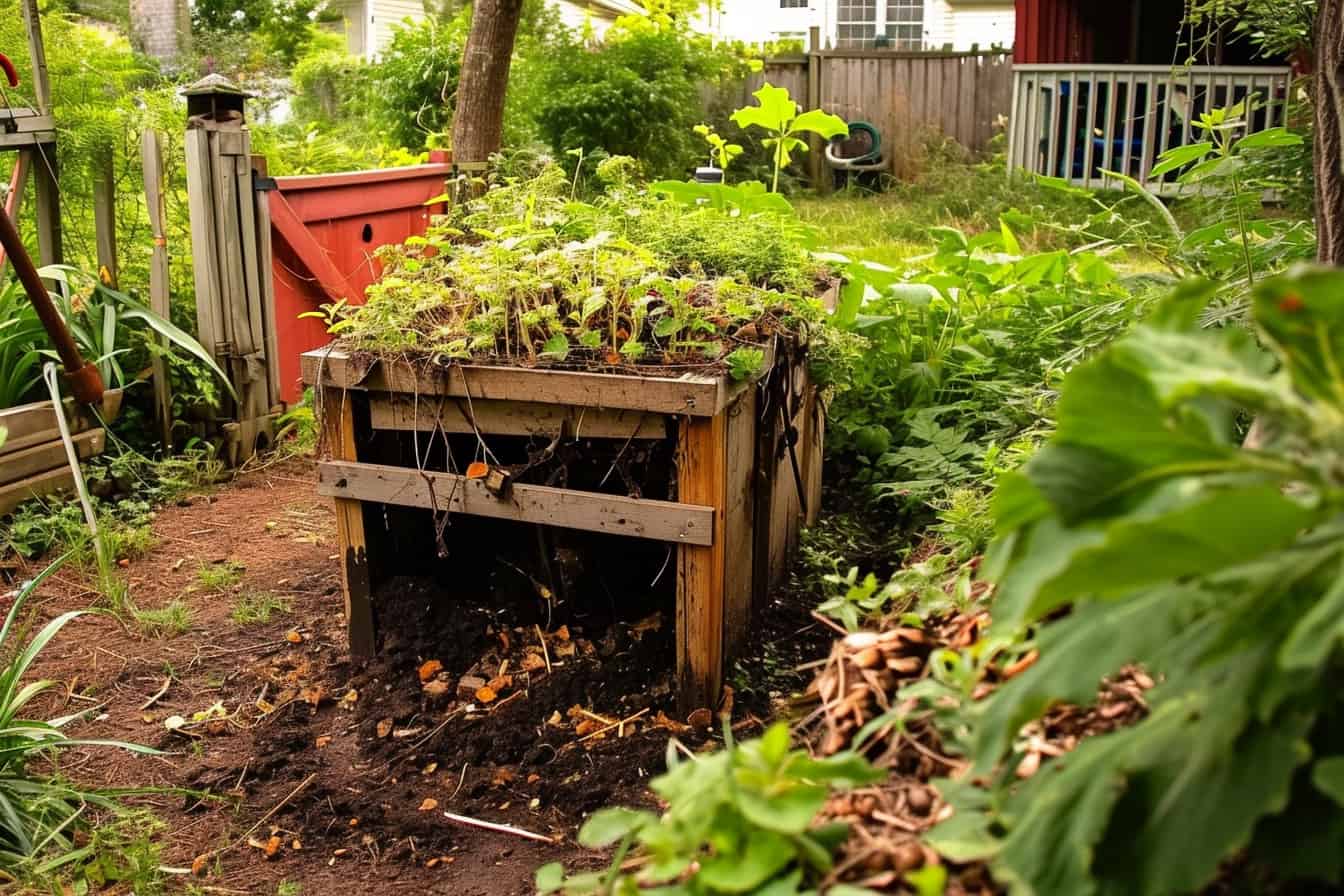
Compost is the black gold of gardening. It’s the result of breaking down organic materials into a nutrient-rich, earthy substance. But it’s more than just a pile of decomposed leaves and kitchen scraps; it’s a powerhouse for your garden.
So, why is composting such a big deal?
- The Definition: Compost is the end product of the natural decomposition of organic materials. It’s a nutrient-rich soil amendment that improves soil structure, enhances moisture retention, and provides essential nutrients to plants.
- The Role in Gardening and Agriculture: Compost is like a multivitamin for your plants. It improves soil fertility, promotes healthy root growth, and helps plants resist diseases and pests. In agriculture, compost can reduce the need for synthetic fertilizers, minimize erosion, and even mitigate climate change by sequestering carbon.
- The Essential Practice: Composting is a sustainable way to manage organic waste. By diverting kitchen scraps and yard trimmings from the landfill, you’re not only reducing methane emissions but also creating a valuable resource for your garden. It’s a win-win for you and the environment.
Composting is not only easy but also incredibly rewarding. When you see your plants thriving, you’ll know that you’re not just a gardener; you’re a soil steward. And the best part? You don’t need a sprawling farm to compost; it can be done in a small apartment or a suburban backyard.
So, whether you’re a seasoned gardener or just starting out, consider composting as a fundamental practice. It’s nature’s way of recycling, and you get to reap the benefits. Just think of compost as your garden’s secret ingredient, and watch your plants flourish like never before.
- Related articles: Compost Calculator
The Benefits of Composting
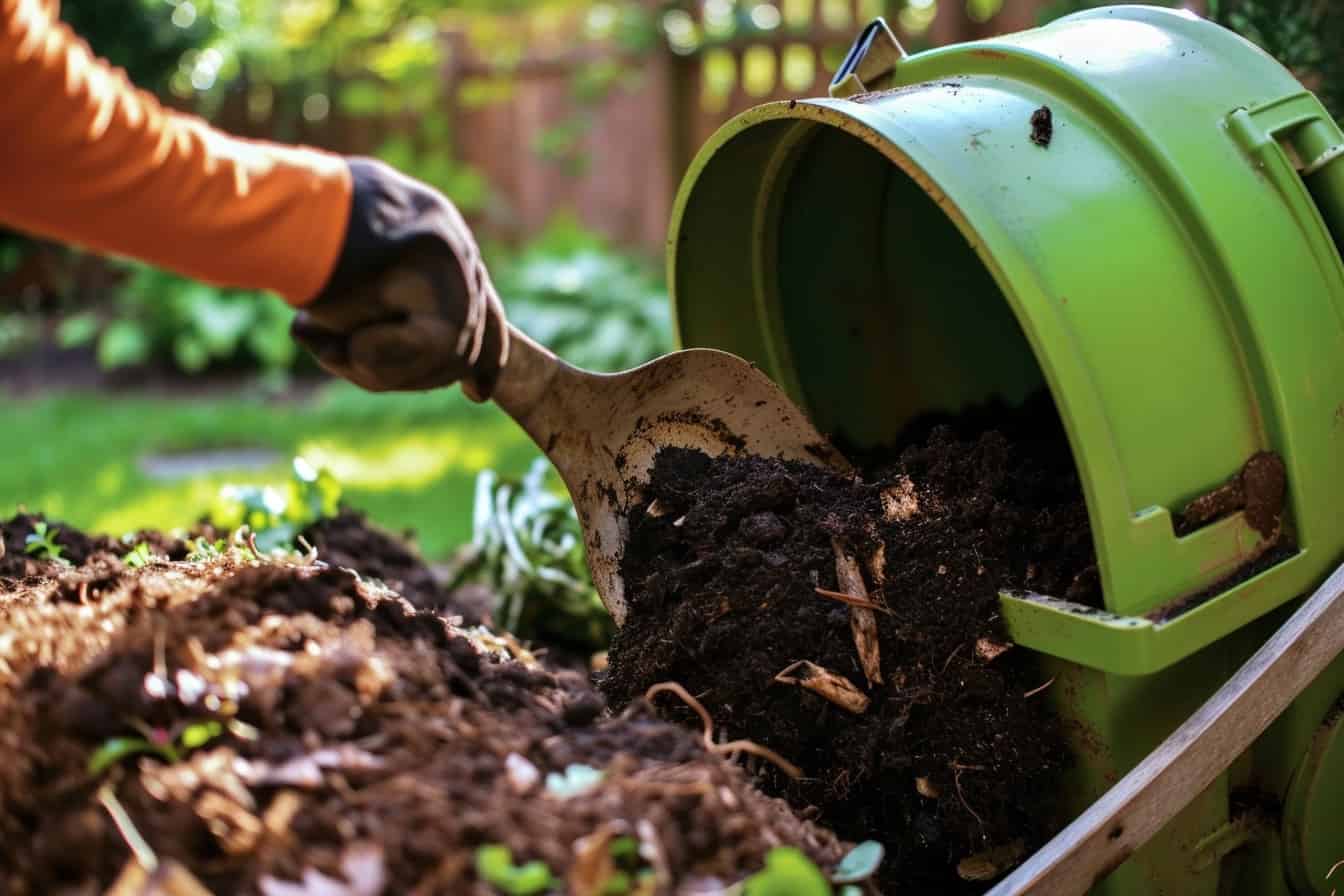
Composting isn’t just a way to repurpose kitchen scraps and yard waste; it’s a game-changer for your garden and the environment. Let’s dig into the benefits you can reap by embracing this natural process.
Composting also improves the soil quality, leading to healthier and more productive plants. Here are the key benefits of composting:
1. Enriching the Soil: A Natural Fertilizer
- Compost is often referred to as “black gold” for a reason. When you incorporate it into your soil, it adds essential nutrients like nitrogen, phosphorus, and potassium.
- This nutrient boost translates into healthier plants, more vibrant blooms, and higher yields in your vegetable garden. It’s like giving your soil a nourishing meal.
2. Improving Soil Structure and Water Retention
- Ever had soil that’s either too sandy or too clayey? Compost to the rescue! It acts as a soil conditioner, improving its structure and texture.
- The result? Soil that’s easier to work with, better at holding moisture, and less prone to erosion. Your plants will thank you for the stable and well-drained environment.
3. Reducing the Need for Synthetic Fertilizers and Pesticides
- By using compost, you’re reducing your reliance on synthetic fertilizers and pesticides. This is not only more eco-friendly but also better for your plants and soil in the long run.
- Compost helps create a balanced ecosystem in your garden, promoting beneficial organisms like earthworms and microbes that naturally fight off pests and diseases.
4. Mitigating Climate Change Through Carbon Sequestration
- Here’s a big-picture benefit: composting helps combat climate change. When organic matter like food scraps and yard waste breaks down in a landfill, it produces methane, a potent greenhouse gas.
- By composting at home or through municipal programs, you’re diverting these materials from landfills, where they can instead decompose aerobically, releasing less methane.
- Additionally, compost is rich in carbon, and incorporating it into the soil helps sequester carbon, reducing its release into the atmosphere.
Composting is a win-win for your garden and the planet. It’s a simple and effective way to enhance your soil, reduce waste, and contribute to a more sustainable future.
Read more about Composting Pros and Cons
What is in Compost?
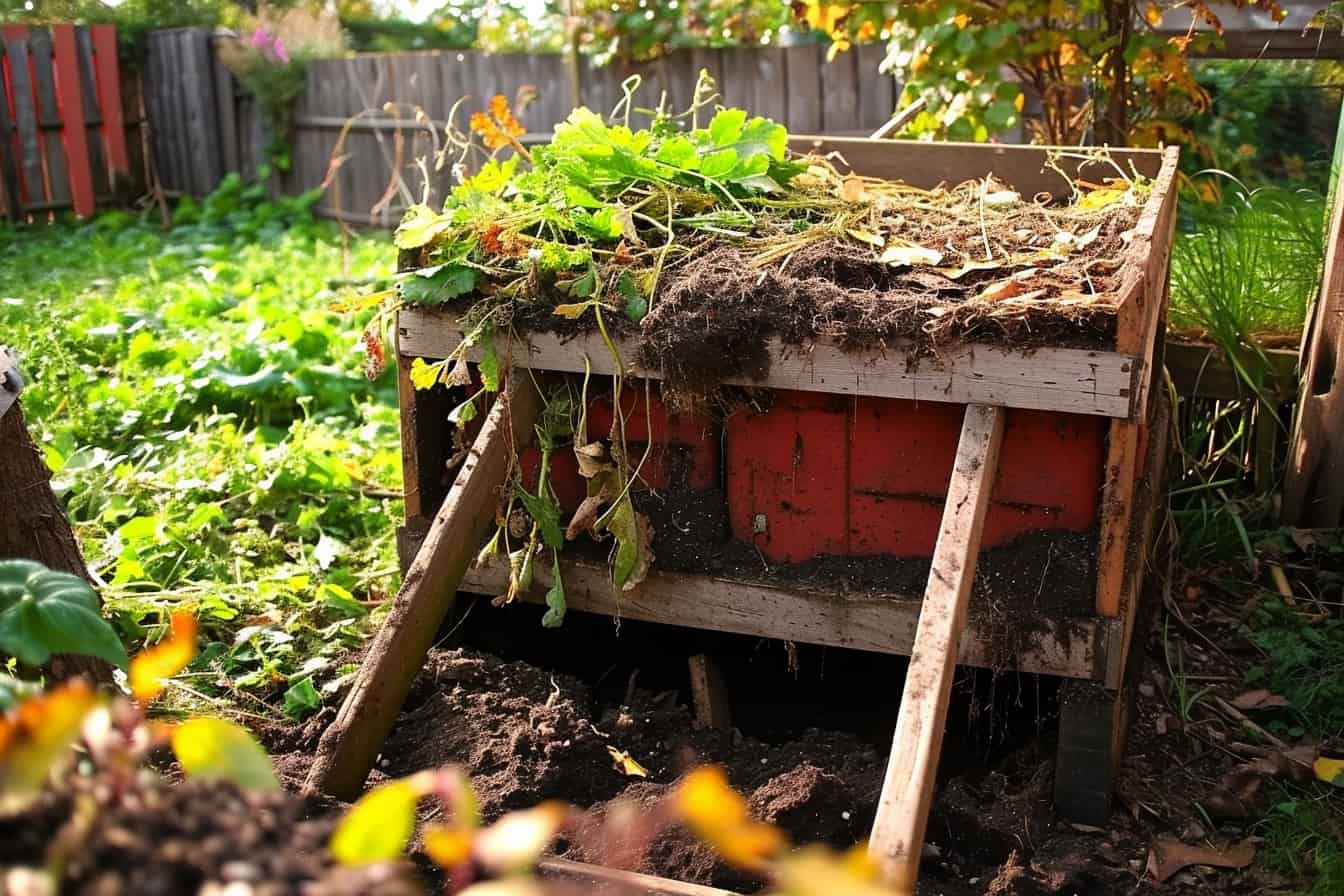
Compost is made up of organic matter. Gardeners use many different types of organic materials in their compost for their organic gardens. Basically, anything that was once alive in the environment can be added to your compost.
Of course, there are practical limitations to this, and you will have to get a good mix of different kinds of matter to get good compost. A compost heap, or composter, should contain different decaying organic materials.
Gardeners categorize organic matter into two groups: Greens and Browns.
- Greens are materials that are high in nitrogen, they break down quickly and usually contain a lot of moisture. Greens are things like plant material (grass clippings, weeds) and food waste from fruits and vegetables.
- Browns are high in carbon, they are slow to break down and are usually dry. Browns are things like wood products, mulch, straw, leaves, newspaper, and shredded paper.
Green materials help to break down browns. Browns keep the compost aerated and stop it from becoming too sludgy and smelly. Good compost is usually a 50/50 mix of greens and browns.
Green and brown materials must be mixed together to create a decent compost collection. Many people are under the misconception that compost is smelly, but a smelly compost heap usually indicates an imbalance in nitrogen and carbon.
Foul odors coming from a compost heap usually mean that there is too much nitrogen. You should add more brown matter to balance it out and neutralize the bad odor.
The resulting compost in the ideal environment has a lovely earthy aroma, and looks like rich earth to grow healthy plants.
The Composting Process: How Does It Work?
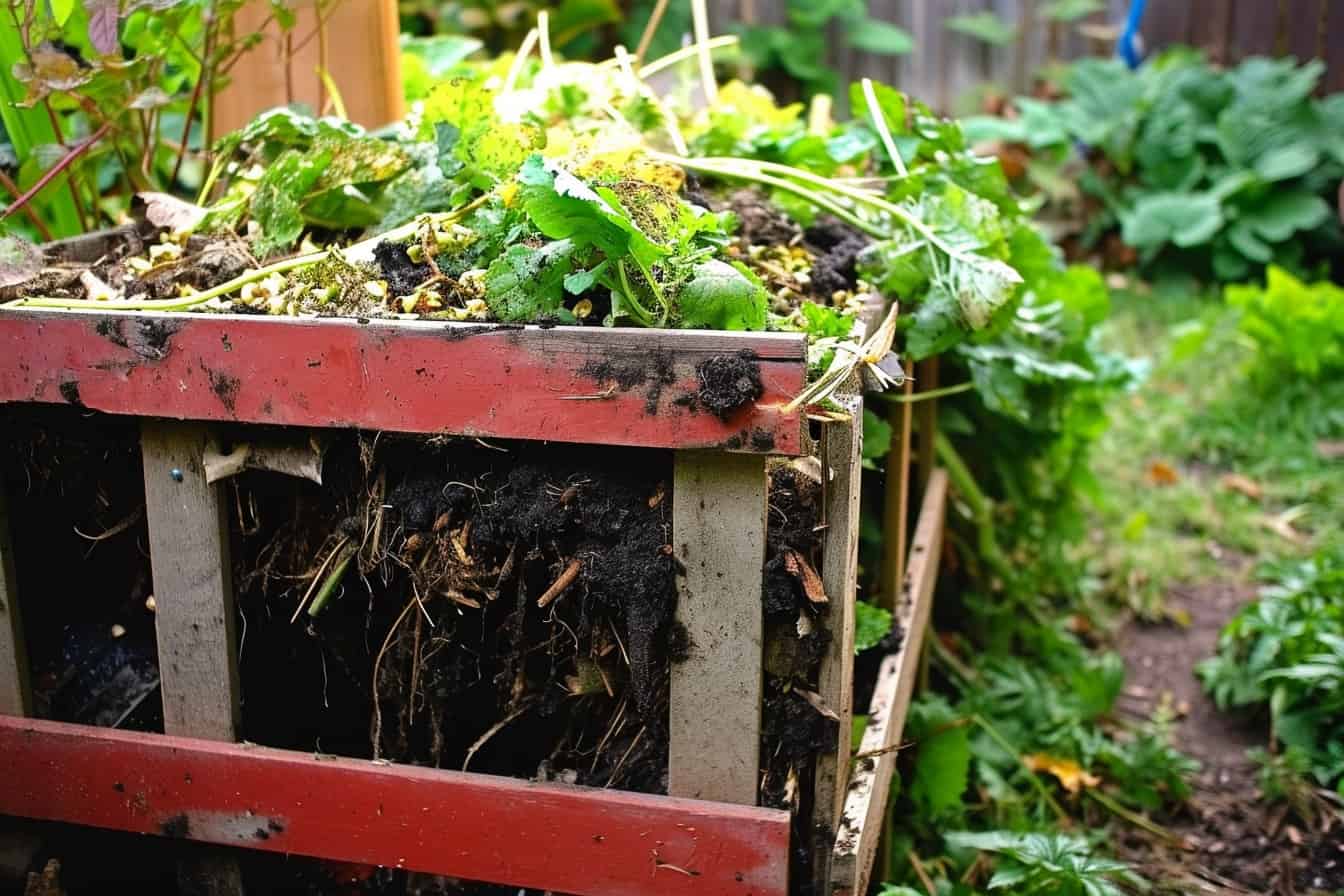
Ready to dive into the inner workings of composting? In this section, we’ll pull back the curtain and explore how organic matter transforms into nutrient-rich black gold for your garden. Get your gardening gloves on; it’s about to get fascinating.
The Science Behind Composting
Let’s dig into the nitty-gritty of composting and uncover the fascinating science that turns kitchen scraps and yard waste into “black gold” for your garden.
- Microorganisms and their role in decomposition
Composting is a microbial party. Bacteria, fungi, and other microorganisms break down organic matter, transforming it into rich, earthy compost. It’s like a miniature recycling plant happening right in your compost bin. - The carbon-to-nitrogen ratio from composting materials and its importance
Think of carbon as the energy source and nitrogen as the building blocks for microorganisms. The ideal carbon-to-nitrogen ratio is roughly 30:1. Too much carbon (like dry leaves) and the process slows down; too much nitrogen (like fresh grass clippings) and you’ll get a stinky mess. - Aeration, moisture, and temperature: The key factors
Compost needs oxygen to keep the microorganisms happy and working. Turning the pile every few weeks or using a compost tumbler helps with aeration. Moisture is crucial too; aim for a damp sponge consistency. Temperature also plays a role. A hot compost pile (around 130-150°F) speeds up the decomposition process and kills weed seeds and pathogens. - The various stages of composting
Composting is a journey with different stages. It starts with the mesophilic stage, where the pile heats up and bacteria take the spotlight. Then comes the thermophilic stage, where the pile gets really hot, and fungi and actinobacteria join the party. Finally, the pile cools down during the maturation stage, and the compost becomes more stable and ready to use.
Understanding the science behind composting can help you troubleshoot and create the best possible environment for your microorganism workforce. So, the next time you’re turning your compost pile, you’ll have a deeper appreciation for the microscopic heroes making it all happen.
Composting Methods and Techniques
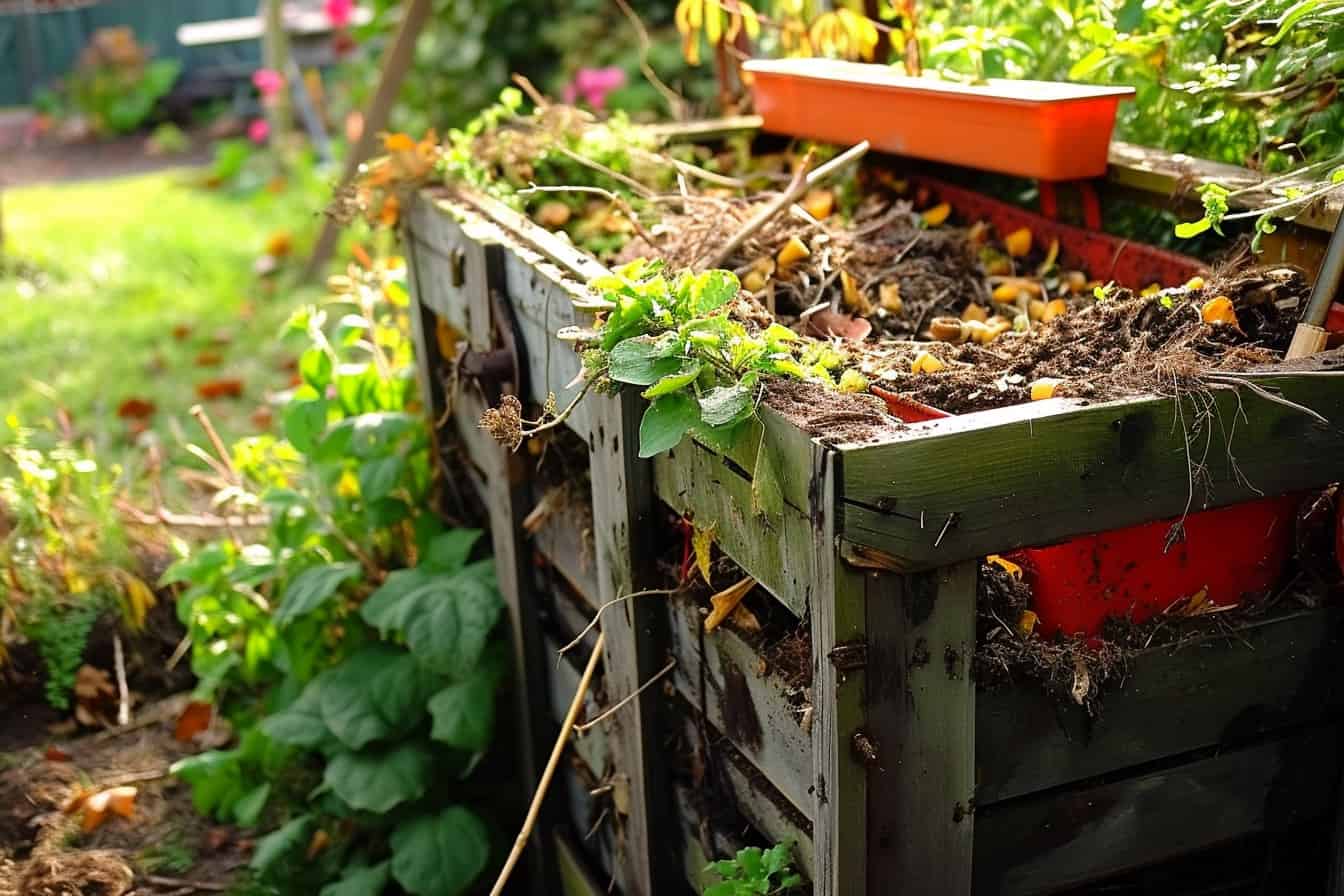
Now let’s get our hands dirty and explore some tried-and-true composting methods. Whether you have a sprawling backyard or a cozy city balcony, there’s a technique that fits your lifestyle and space.
- Traditional Backyard Composting
This is the classic method you’ve probably seen your grandparents use. It involves layering brown and green materials in a designated area and letting nature do its thing. It’s low-cost, low-maintenance, and yields rich, earthy compost. - Vermicomposting With Worms
If you’re a fan of efficiency and want to compost indoors, vermicomposting (worm composting) is your go-to. Red wiggler worms are the stars here, breaking down kitchen scraps into nutrient-rich castings. It’s a great option for apartment dwellers or anyone with limited outdoor space. - Bokashi Composting and Other Alternatives
Bokashi, a Japanese fermentation method, and other alternatives like trench composting or pit composting are perfect for those who want to compost meat, dairy products, or oily items that aren’t recommended in traditional compost piles. These methods are faster and can handle a wider range of materials. - Compost Tumblers and Bins: A Modern Approach
For the tech-savvy or time-pressed among us, compost tumblers and bins offer a streamlined experience. These enclosed systems speed up the composting process and keep pests at bay. They’re ideal for small yards or even balconies.
I’ve personally used a combination of traditional backyard composting and a worm bin, and the results have been fantastic. The key is finding a method that suits your needs and lifestyle.
So, whether you’re taking the traditional route or embracing the latest composting gadget, the end goal is the same: nutrient-rich finished compost that will supercharge your garden.
Types of Backyard Composting
When it comes to backyard composting, there are: cold and hot composting.
As a gardening enthusiast, you’ve likely pondered the different approaches to transforming your kitchen scraps and yard debris into nutrient-rich compost. In our backyards, we generally see two main composting types: hot composting and cold composting.
1. Hot Composting
If you’re aiming for quick results, hot composting is your go-to. This active method is all about creating the ideal conditions for rapid decomposition: a blend of high heat, ample oxygen, moisture, and a diverse mix of organic matter. When these elements are in harmony, you’re on your way to creating compost that gardeners often refer to as “black gold.”
In hot composting, the elevated temperatures are the workhorse, accelerating the breakdown of materials so you can enjoy usable compost in a matter of months. Not only does this heat hasten the process, but it also serves as a sanitizing agent, eliminating unwanted organisms like pathogens, bacteria, and parasites from your organic waste.
However, this method does ask for a bit more from you. Regular monitoring and turning of the compost pile are crucial to maintain those high temperatures necessary for efficient decomposition.
2. Cold Composting
On the flip side, cold composting is the more laid-back approach. It’s as simple as adding your organic waste to the pile and letting nature take its course. The breakdown happens at a leisurely pace, and while it might take a year or more for the compost to mature, the process is nearly effortless on your part.
Cold composting doesn’t rely on any added heat; instead, it counts on the natural breakdown of materials over time. To kick things off, just stack your green and brown materials, ensuring they have enough air and moisture to decompose at their own pace.
What’s wonderful about this method is the minimal upkeep. You can leave your pile to sit, letting the elements do their thing, and eventually, you’ll be rewarded with compost that’s just as rich in nutrients as what you’d get from hot composting.
Which Type of Composting is Best?
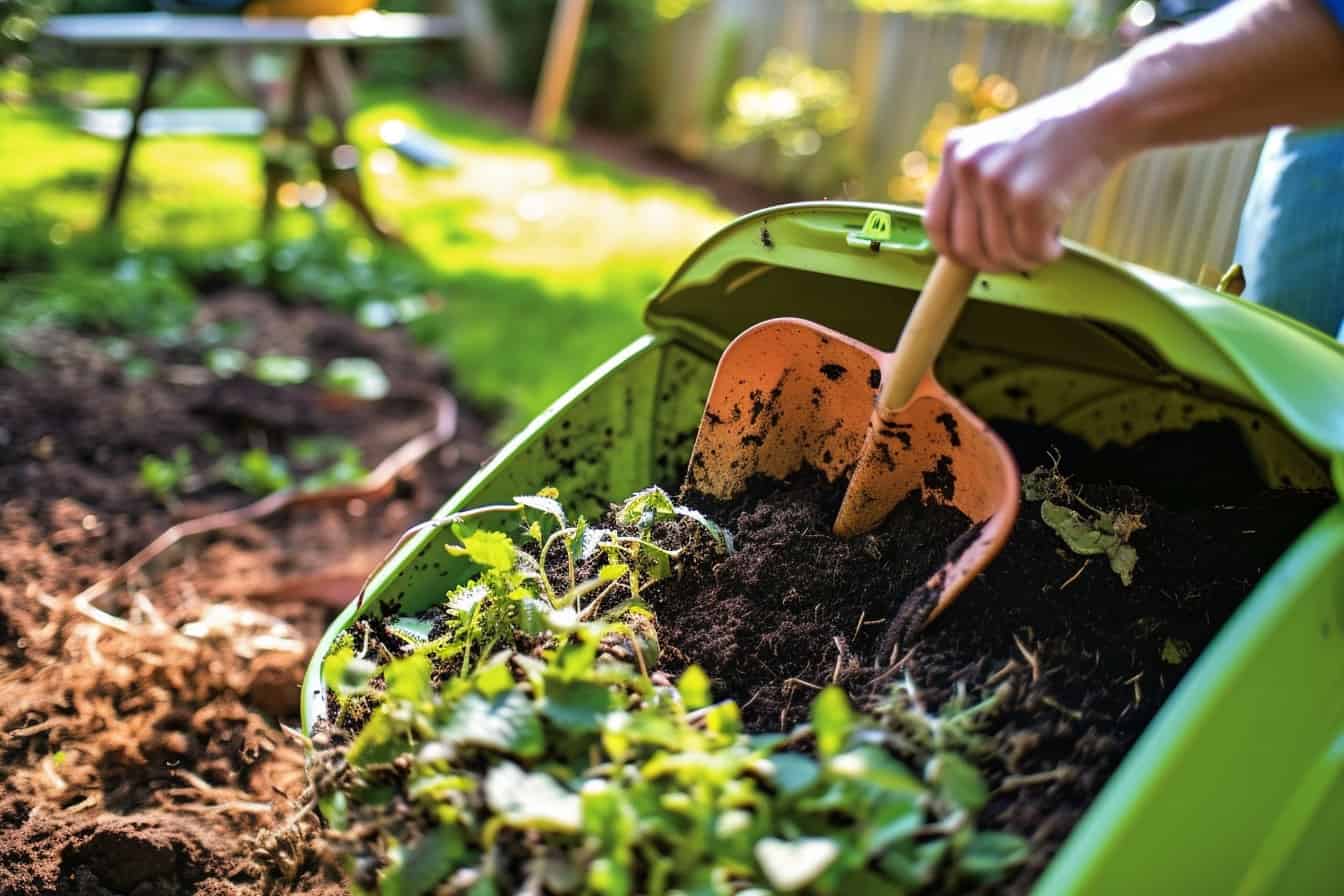
Deciding between hot and cold composting boils down to a few factors:
- The volume of organic waste you have
- The time you can dedicate to pile maintenance
- Your composting goals.
For those with a substantial amount of waste and the willingness to engage in a bit more upkeep, hot composting is the answer. But if you prefer a more hands-off approach with less waste, cold composting is the less demanding alternative.
Consider hot composting if you’re concerned about weeds or pathogens, as the high temperatures can help prevent them from surviving in your compost.
No matter which path you choose, remember that the success of your compost hinges on maintaining the right balance of ingredients and ensuring the pile is well-aerated to avoid anaerobic conditions. This oxygen-rich environment is vital for the microorganisms that will break down your waste into high-quality compost.
In the end, both methods require attention to detail to produce compost that is not only free from undesirable elements but also enhances plant growth and reduces the reliance on chemical treatments in your garden.
Incorporating either of these composting techniques into your gardening practice is a step towards a healthier garden and a more sustainable lifestyle. Whether you’re a seasoned composter or a beginner, understanding the nuances of hot and cold composting will help you make the best choice for your garden’s needs.
Composting for Different Gardening Needs
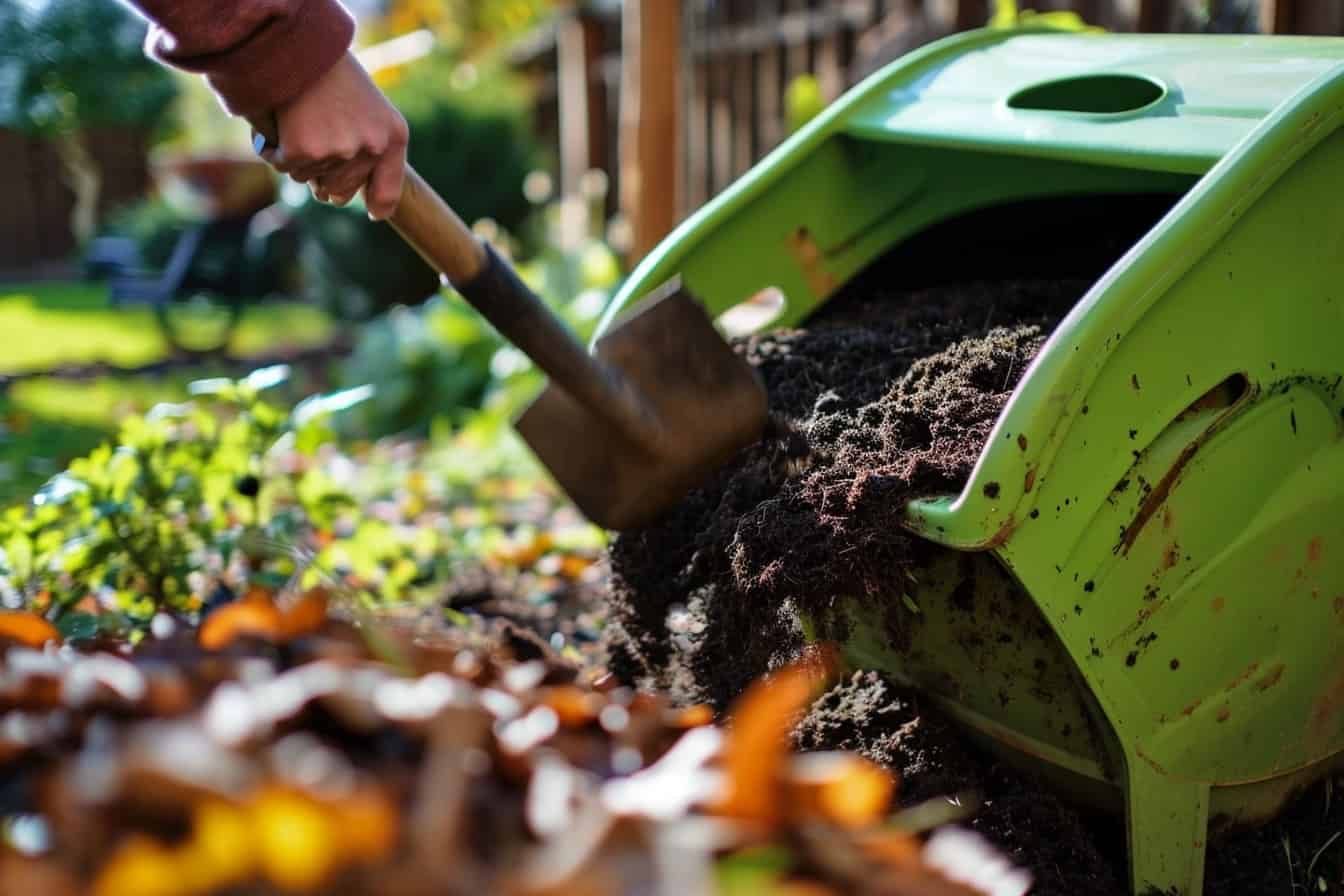
Whether you have a sprawling vegetable garden or a collection of potted plants on your balcony, compost can be tailored to suit your specific gardening needs. The beauty of composting lies in its versatility, as it can enrich soil, boost plant growth, and even deter pests. Let’s explore some actionable tips on how to compost for various gardening endeavors.
Compost for Vegetable Gardens
If you’re an avid veggie gardener like me, you know that the quality of the soil directly impacts your harvest. That’s why compost is a game-changer. It enriches the soil with essential nutrients, improves its structure, and enhances moisture retention.
Here’s how you can make the most of compost in your vegetable patch:
1. The Perfect Blend: Nutrient-Rich Produce
- Aim for a compost blend that’s high in organic matter, such as kitchen scraps, leaves, and grass clippings.
- This mix ensures a steady release of nutrients, promoting healthy growth and robust flavors.
2. Top Dressing or Raised Beds: The Choice is Yours
- As a top dressing: Spread a thin layer of compost around your veggies, leaving some space around the stems. This acts as a slow-release fertilizer and weed suppressant.
- In raised beds: Mix compost with your existing soil in a 1:1 ratio. The raised bed structure helps with drainage and prevents soil compaction.
3. Compost Tea: Liquid Gold for Plants
- This is like a vitamin boost for your plants. Steep a handful of compost in a bucket of water for a few days, then strain and use the liquid as a foliar spray or soil drench. Your veggies will love it.
In my experience, compost-amended soil has led to more bountiful and flavorful harvests. Just remember these key points:
- Always use fully decomposed compost to avoid burning your plants.
- Apply compost in early spring or fall for best results.
- Test your soil regularly to ensure a balanced nutrient profile.
Whether you’re growing tomatoes or carrots, compost is your garden’s best friend. So, don’t discard those kitchen scraps; turn them into black gold and watch your vegetable garden thrive.
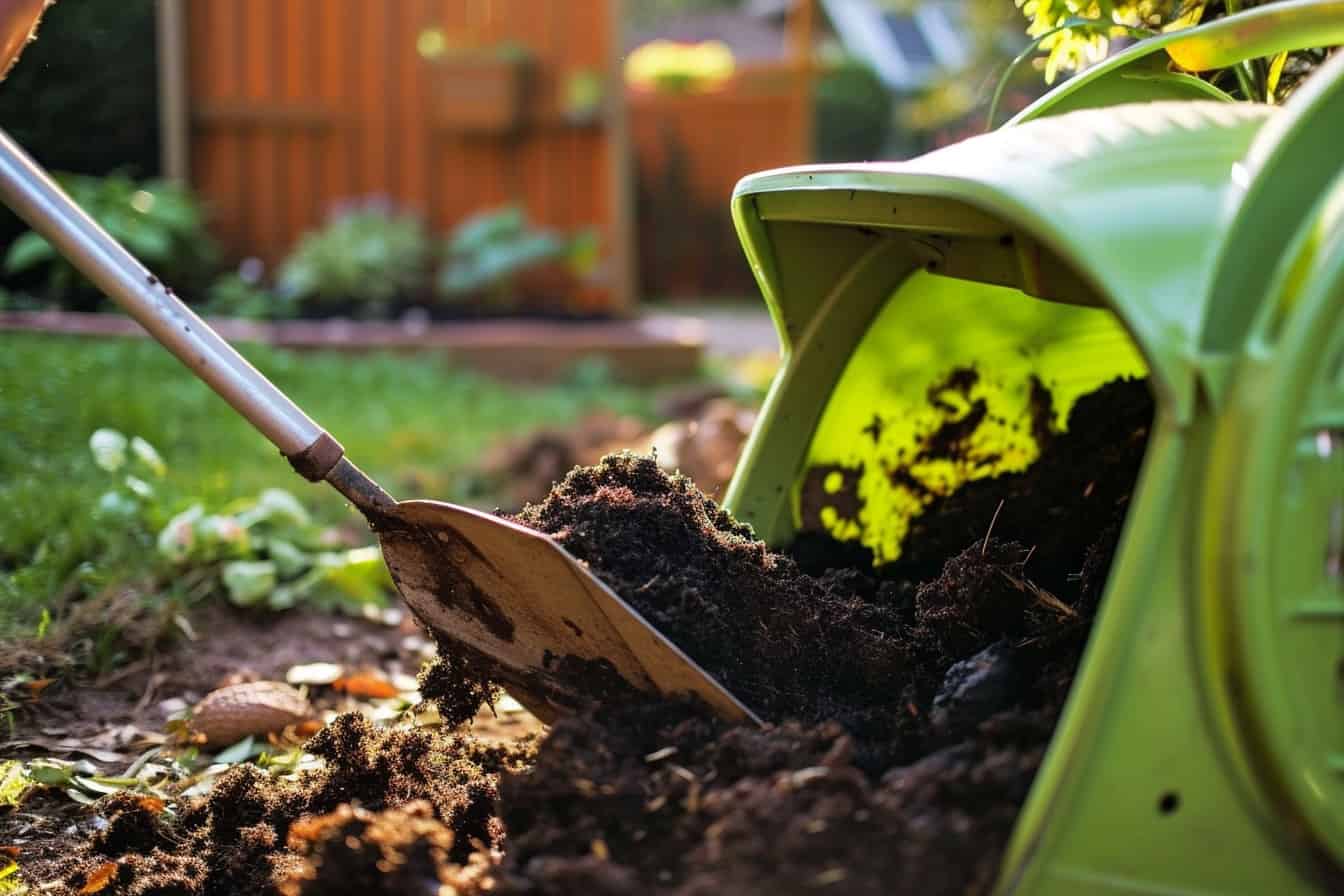
Compost for Flower Beds and Ornamental Plants
If you’re like me and find solace in the vibrant hues and intoxicating scents of a flower garden, then compost is your secret weapon. Here’s how you can elevate your floral game with this black gold:
1. Enhancing Color, Size, and Fragrance
- Rich in nutrients and beneficial microorganisms, compost promotes robust growth, resulting in more vivid flower colors and larger blooms.
- The organic matter in compost improves soil structure, allowing roots to access water and nutrients more efficiently, leading to healthier, more fragrant flowers.
2. Mulch or Soil Amendment?
- As a mulch: Spread a layer of compost around your flowers, leaving a few inches of space around the stems. It acts as a protective blanket, reducing weed growth and moisture loss.
- As a soil amendment: Before planting, mix compost into the top few inches of soil. This improves drainage in heavy soils and enhances water retention in sandy ones.
3. Compost and Container Gardening
- When using compost in containers, blend it with a high-quality potting mix. This ensures a well-draining, nutrient-rich environment for your potted beauties.
- For established container plants, top-dress with compost annually to replenish nutrients and improve soil structure.
In my experience, flower beds and ornamental plants respond exceptionally well to regular doses of compost. The colors become more vibrant, the blooms last longer, and the fragrance is simply divine.
Whether you’re using it as a mulch, soil amendment, or in containers, compost is a game-changer for your floral displays and for healthy soils.
What Can Be Composted?
Pretty much any organic materials can be composted, although there are a few things that you’ll want to avoid. Let’s take a look around your home and life to see what things you can compost:
1. Things to Compost From the Garden and Lawn
From your lawn and garden, you can compost:
- Plant trimmings and cuttings
- Dead plants
- Grass clippings
- Dead leaves
- Twigs
- Branches
- Wood chips
Things you’ll want to avoid are any plants that are showing signs of disease. They should not be added to your compost as you run the risk of spreading plant diseases.
2. Things to Compost From the Kitchen
Many things from the kitchen are perfect additions to your compost:
- Food scraps like fruit and vegetable scraps, like peelings
- Old fruit or vegetable waste that is no longer edible
- Egg shells
- Stale bread, cereal, pasta
- Used teabags and tea leaves
- Used coffee grounds/grinds
- Paper towels and egg cartons
Some people compost cooked food, but I advise against it because they might attract unwanted pests. Raw meat should also be avoided for the same reason.
Raw and cooked meat can also harbor harmful bacteria and pathogens, so it’s best avoided altogether.
There are some composters on the market that are designed to compost cooked food, but if you have an open pile, then it’s best to avoid foods that will attract scavengers.
Kitchen composting is one of the best and main sources of compost ingredients.
3. Things to Compost From Home
Items you can compost in your home include:
- Newspapers
- The cardboard inner tube of toilet rolls
- Hair
- Nail clippings
- Scrap paper
- Cardboard (Learn more about cardboard composting)
- String
- Items made from natural materials like silk, cotton or wool.
4. Things to Compost From Pets and Animals
Animal products are a popular, natural organic waste to add to the pile. If you have pets, they can provide compost material:
- Pet hair and feathers
- Pet waste and droppings, preferably if your pet is an herbivore and fed fresh fruits and vegetables
Farm animals and other larger animals like horses, cows, and chickens can provide manure, but only if from herbivores (vegetable and plant eaters, non-meat).
Fresh manure is too strong to use directly in your garden though. It must be left to decompose for at least a month before being used. Adding it to your compost is the ideal solution.
If you have cats, learn more about composting cat poop and cat litter here. If you have dogs, learn more about composting dog poop here.
Troubleshooting Common Composting Issues
Composting is a natural process, but sometimes, things can go awry. Don’t worry; I’m here to help you troubleshoot those common composting conundrums. Let’s dive right in:
1. Foul Odors and How to Prevent Them
Nobody likes a stinky compost pile. The main culprits behind those putrid smells are usually too much moisture or an imbalance in the carbon-to-nitrogen ratio. Here’s what you can do:
- Aerate: Turn the pile more frequently to introduce oxygen and reduce the stench.
- Add dry materials: If it’s too wet from carbon-rich green materials, mix in some dry leaves or straw (brown materials) to absorb the excess moisture.
- Avoid meat and dairy: These can lead to foul odors and attract unwanted critters.
2. Dealing with Pests and Critters
You’re not the only one who finds compost intriguing. If you spot uninvited guests like rats or raccoons, try these tips:
- Secure your pile: Use a sturdy bin or fencing to keep critters out.
- Avoid food scraps: If critters are a persistent problem, consider a compost system that excludes food scraps.
3. When the Compost Isn’t Decomposing
If your compost is just sitting there, not breaking down as it should, here’s what you can do:
- Check the balance: Ensure you have a good ratio of carbon-rich browns (leaves, straw) and nitrogen-rich materials, greens (grass clippings, kitchen scraps).
- Chop it up: Smaller pieces decompose faster, so run your garden waste through a chipper or give it a good chop before adding it to the pile.
- Moisten or dry: Adjust the moisture level. If it’s too dry, add water; if it’s too wet, add more dry materials.
4. Balancing the Compost: Tips for Adjusting the Carbon-to-Nitrogen Ratio
Getting the carbon-to-nitrogen ratio right is crucial for efficient decomposition. Here’s a quick cheat sheet:
- Too much carbon: Your pile may be dry and slow to decompose. Add some nitrogen-rich greens to balance it out.
- Too much nitrogen: You might be dealing with a smelly, slimy mess. Add more carbon-rich browns to even things out.
Remember, composting is a dynamic process. Don’t be discouraged if you encounter a bump in the road. With a little troubleshooting, you’ll be back on track to creating rich, dark compost that your plants will love.
Taking Composting to the Next Level
Composting isn’t just a hobby for your backyard anymore; it’s a movement that extends far beyond your garden gate. Let’s explore how composting is making waves in communities, industries, and even the realm of innovation.
Community Composting Initiatives
Joining a community composting initiative is like becoming part of a green revolution. These programs bring neighbors together to share resources, reduce waste, and create nutrient-rich soil for local gardens.
You may find compost drop-off sites, shared composting bins, or even composting workshops in your area. It’s a fantastic way to connect with like-minded individuals and make a collective impact on the environment.
Large-Scale Composting for Commercial Use
On a grander scale, composting has found its way into commercial products and operations. From restaurants and hotels to sports arenas and theme parks, businesses are recognizing the value of diverting organic waste from landfills.
The resulting compost is then used in landscaping, agriculture, and even as a soil amendment in construction projects. By participating in these initiatives, businesses not only reduce their carbon footprint but also create a closed-loop system from the waste stream that benefits the local community.
The Future of Composting: Innovations and Trends
As with any field, composting is evolving. Innovations like in-vessel composting, anaerobic digestion, and vermicomposting are gaining traction. These methods allow for faster decomposition, odor control, and the ability to compost a wider range of materials.
Technology is playing a significant role, with smart composting systems that monitor temperature, moisture, and aeration. The goal is to make composting more efficient, accessible, and tailored to individual needs.
Composting has come a long way from a simple backyard practice. It has transformed into a community-driven, commercially viable, and technologically advanced endeavor.
By embracing these advancements, we can all take our composting game to the next level, reducing waste, enriching our soils, and contributing to a greener future.
Final Thoughts on Composting
Composting is more than just a gardening practice; it’s a way to nurture the Earth and create a more sustainable future.
By understanding the science, troubleshooting common issues, and tailoring compost to your gardening needs, you can unlock its full potential. The benefits are far-reaching, from enriching your soil and reducing waste to combating climate change.
I remember my first batch of compost. The rich, earthy scent and the sight of worms happily wriggling through it were signs that I was doing something right. And when I saw how my plants thrived, I knew I had tapped into a gardening secret.
Compost isn’t just a fad; it’s a tried-and-true method that’s been used for centuries. The best part? You don’t need a fancy setup to get started. A simple pile in a corner of your yard or a compact bin on your balcony will do the trick.
So, whether you have a sprawling garden or a cozy balcony, I encourage you to give composting a try. It’s a simple yet powerful way to connect with nature and make a positive impact.
Your plants will thank you, and you’ll be part of a growing movement to create healthier, more vibrant communities. Let compost be your garden’s secret ingredient, and watch your plants flourish like never before.
Composting FAQs
What is compost made of?
Compost is crafted from a mix of organic materials, which typically include kitchen scraps like fruit and vegetable peels, yard waste such as leaves and grass clippings, and brown materials like cardboard and paper.
The key is to balance ‘greens’ rich in nitrogen, and ‘browns’ high in carbon, to foster the right conditions for microorganisms to thrive. This balance speeds up decomposition, turning waste into nutrient-rich humus that enhances soil health.
As I’ve found in my own composting adventures, monitoring moisture and aeration is crucial to support the composting process.
How do you make compost?
Making compost involves combining organic waste, like kitchen scraps and yard debris, in a bin or pile. Here’s a quick guide to get you started:
1. Balance ‘greens’ and ‘browns’: Aim for a mix of nitrogen-rich material (greens like vegetable peelings) and carbon-rich items (browns like dry leaves).
2. Chop materials: Smaller pieces decompose faster.
3. Aerate: Turn your pile every few weeks to introduce oxygen.
4. Moisture check: Your compost should be damp, but not soaking wet.
5. Patience: It can take a few months to a year for compost to mature.
Can you buy compost online?
Certainly, purchasing compost online is an option for gardeners. You’ll find a range of compost types available from various retailers, suited to different gardening needs. Here are a few tips for buying compost online:
– Research: Look for reputable sellers with positive reviews.
– Quality: Ensure the compost is suitable for your intended use.
– Shipping: Check shipping costs, as compost can be heavy and expensive to deliver.
– Local Options: Sometimes local suppliers may offer better deals, even online.
Remember to check your local regulations, as some areas have restrictions on importing organic materials. You can purchase bags of compost online through websites such as Amazon.com.
What should not go in compost?
While composting is a fantastic way to recycle kitchen and garden waste, some items should be left out:
– Meat, fish, and dairy products can attract pests and cause odor.
– Oils and greases also attract pests and can disrupt the compost balance.
– Diseased plants may spread pathogens to the compost pile.
– Pet wastes can introduce harmful bacteria or parasites.
– Non-biodegradable materials like plastic, metal, or glass won’t break down.
By avoiding these items, you’ll ensure a healthier composting process and end product for your garden.
Materials that should not go into compost include: cooked food, meat, dairy products, fish, eggs, oil-based foods, plastics, batteries, paints, cleaning supplies, chemical pesticides, chemical fertilizers, animal bedding, diapers, sanitary napkins, cotton balls, tissues, styrofoam, balloons, condoms, tampons, toothpaste tubes, toilet tissue rolls, plastic wrap, aluminum foil, tin cans, glass bottles, metal utensils, and styrofoam.
Does compost turn into soil?
No, compost doesn’t transform into soil; rather, it acts as a nutrient-rich amendment. When you mix compost into your garden, it enhances the existing soil’s structure, fertility, and microbial life. Think of it as a superfood for your garden beds, bolstering plant growth and health.
What is compost used for?
Compost serves as a nutrient-rich soil amendment, promoting healthier plant growth. By mixing it into garden beds, you enhance soil structure, moisture retention, and microbial activity.
Compost is perfect for enriching vegetable gardens, creating potting mixes, or as a natural fertilizer for your lawn. Use it as mulch to suppress weeds and protect plant roots. In essence, compost is your go-to for maintaining a vibrant and sustainable garden ecosystem.
When is compost finished?
Determining when your compost is ready involves a few telltale signs. You’ll know it’s finished when the material is dark, crumbly, and has an earthy smell.
It should also be cool, indicating the microbial activity has slowed down. If you can still recognize the original organic materials, give it more time.
A simple test is to bag a small sample and sniff for any ammonia-like odors after a few days; absence of such smells suggests your compost is mature and ready to enrich your garden.
Sources:
- http://compost.css.cornell.edu/monitor/monitorph.html
- https://www.epa.gov/recycle/composting-home
- https://onlinelibrary.wiley.com/doi/10.1002/jpln.19881510512
- https://pubmed.ncbi.nlm.nih.gov/18256821/
- https://pubmed.ncbi.nlm.nih.gov/24085838/
- https://www.agric.wa.gov.au/climate-change/composting-avoid-methane-production

